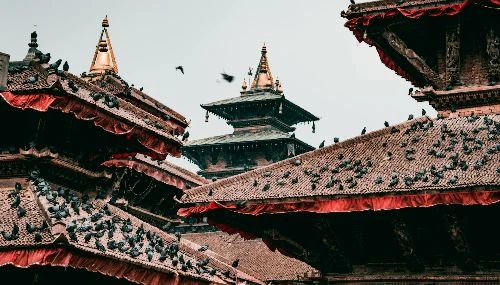If you’re planning to trek to Kanchenjunga, the world’s third-highest mountain, you should know that it is quite challenging due to its remote location. You will need to be physically fit and mentally prepared for the adventure.
Graded as a strenuous trekking destination, the Kanchenjunga trek will test your limits, but the reward is an unforgettable experience in a stunning part of the world.
You’ll be hiking at over 5,000 meters (16,404 feet) battling thin air and unpredictable weather. The terrain itself adds to the challenge, with rough paths, rocky climbs, and steep sections requiring short ropes for safety.
As you go higher up, the trails get more steep, especially from following river valleys to ascending upward.
Since remoteness means limited medical access, getting in great shape beforehand is super important. You must prepare for the trek at home by taking long walks with a backpack, doing leg exercises, and swimming. This helps you build up your stamina and strength for the trip.
Not to mention, altitude sickness becomes a growing threat as you approach Base Camp. The air gets thinner and walking tougher so you must take it slow and schedule rest days to help your body adjust.
Temperatures change dramatically depending on where you are. Expect cool nights (around 5°C) and potentially warm days (up to 25°C) at lower altitudes. Higher up, it can get much colder, even dropping to -20°C at night. Thermal layers are your friend here, so bring plenty of clothes to stay warm and protected from the sun.
Here are the details about what makes the Kanchenjunga trek challenging.
Remote Location and Rugged Terrain
Unlike some more crowded treks, Kanchenjunga takes you deep into Nepal's isolated areas. You'll be far from villages and towns, and access to facilities like shops and restaurants will be limited and you will need to carry most of your supplies with you.
Also, you might not have a good phone or internet service during the trek. It's good to take a break and enjoy the moment, but it's important to stay alert in case of an emergency.
Furthermore, the terrain on this trek is definitely challenging. Get ready for steep climbs and descents, plus narrow paths that might be rocky or uneven. Good-quality hiking boots, sturdy poles, and a comfortable backpack are your best friends on this trek. They'll help you with those climbs and keep you comfortable on the trails.

Elevation and Altitude Sickness
The Kanchenjunga trek is an amazing adventure, but there's no denying it – things get tough as you climb higher.
You'll be reaching some serious heights nearly 5,000 meters (16,404 feet) to be exact! At this altitude, the air gets thinner, which means there's less oxygen for your body to use. This can make you feel tired, headache, and even nauseous. These are the symptoms of altitude sickness.
Altitude sickness is a common problem for trekkers in the Himalayas, and Kanchenjunga is no exception. It can give you headaches, nausea, dizziness, and even make you feel short of breath.
However, altitude sickness is preventable. The most important thing is acclimatizing, which means slowly getting your body used to the thinner air. This involves taking rest days at higher elevations and gradually increasing the altitude you reach each day. By listening to your body and following a good acclimatization plan, you can enjoy this trek.
Trekking Hours, Distance, and Duration
The Kanchenjunga trek usually lasts 19 to 24 days and covers about 136 miles (220 km). But it can be shorter or longer depending on how fit you are and what you prefer. Each day, you'll walk for about 6-7 hours, covering 8 to 12 kilometers.
The extended timeframe of the trek pushes trekkers both physically and mentally. You’ll be backpacking for nearly a month straight, carrying everything you need on your back, and constantly surrounded by a challenging environment.
Over nearly a month, you'll need to maintain a consistent routine of daily hikes, manage your energy levels, and stay focused and motivated throughout the journey.
Furthermore, the trek involves walking long distances every day, usually between 8 to 12 kilometers. Doing this day after day can be tough and can make you feel tired and sore.
Moreover, spending an average of 6-7 hours each day actively, trekking can be incredibly tiring, especially considering the high altitude. Even for experienced trekkers, this extended period of exertion can be physically draining.
You’ll be hiking for almost a full day every day for weeks, often in thin air where your body has to work harder to get the oxygen it needs.
Accommodation and Meals
While the incredible scenery and challenging hikes are the main highlights of the Kanchenjunga trek, the relatively undeveloped nature of the route presents its own set of difficulties, particularly when it comes to accommodation and meals.
Unlike more established teahouse treks, the Kanchenjunga route offers mostly basic lodges and teahouses. Although it's doable, they lack the amenities you might find elsewhere. You get shared bathrooms and bucket showers, especially in higher-altitude villages like Pang Pema and Ramche. You must be prepared to adapt to a more rural environment compared to other trekking regions.
Due to the remoteness of the Kanchenjunga region, lodges have limited access to a wide variety of menus compared to other treks. But remember, there will always be Dhal-Bhat on the menu! The variety of options will likely be limited and repetitive throughout the trek, with most teahouses offering similar menus of dal bhat, thukpa (noodle soup), and basic noodles.
Despite the simplicity of the meals, food costs can be surprisingly high on the Kanchenjunga trek. Even simple items may be more expensive than you'd expect. Don’t forget to budget accordingly and be prepared to manage with a more basic selection of food options.
Temperatures and Weather
Trekking in the Kanchenjunga region is tough, mainly because of the weather. Situated high up, the weather there is really unpredictable. During the day, it might be okay, but at night, temperatures can drop below freezing, especially in the higher areas. You have to pack warm clothes, even in the warmer months.
Plus, the weather can throw all sorts of challenges at you. Snow, rain, hail, and strong winds can make trekking even harder. That's why choosing the right time to go is very important. The best months are April, May, September, October, and November. During these times, the weather is more stable, with fewer chances of rain or snow.
On the flip side, you'd want to avoid monsoon season, starting in June, because heavy rainfall can make trekking dangerous. Similarly, winter, from December to February, brings freezing temperatures that need proper gear and planning.
As for the temperatures, during Summer (March to May), temperatures range from a cool 10°C (50°F) to a comfortable 28°C (82°F), with May being the warmest month.
Likewise, during Monsoon (June to September) temperatures likely remain moderate, but the heavy rainfall makes trekking dangerous, so this season is best avoided.
And during Winter (December to February), brace yourself for the cold as it gets really chilly, with temperatures dropping to -5°C (23°F). And even when it's not freezing, it only warms up to around 16°C (61°F).

Important Tips to Prepare for Your Kanchenjunga Trek
These tips will make sure you're prepared for a safe and fun adventure.
- This trek is strenuous, pushing you to your limits with high altitude and demanding trails. Train beforehand with long hikes carrying a backpack, leg exercises, and swimming to build up stamina and strength.
- As you climb higher, the thinner air reduces oxygen, leading to headaches, nausea, and fatigue. Acclimatize properly by taking rest days and gradually increasing altitude each day.
- Unlike other treks, Kanchenjunga ventures into remote areas with limited access to shops, restaurants, and phone/internet service. Carry most supplies with you and be prepared for what’s to come.
- As you’ll be trekking through steep climbs, descents, and uneven paths. Invest in good-quality hiking boots, sturdy poles, and a comfortable backpack to trek comfortably.
- You’ll be hiking at high altitudes, which can be tiring. Pace yourself and manage your energy effectively to avoid exhaustion.
- Temperatures can change dramatically. Pack layers to adapt to cool nights (around 5°C) and potentially warm days (up to 25°C) at lower altitudes. Higher up, brace for much colder nights reaching -20°C.
.webp)

.webp)

